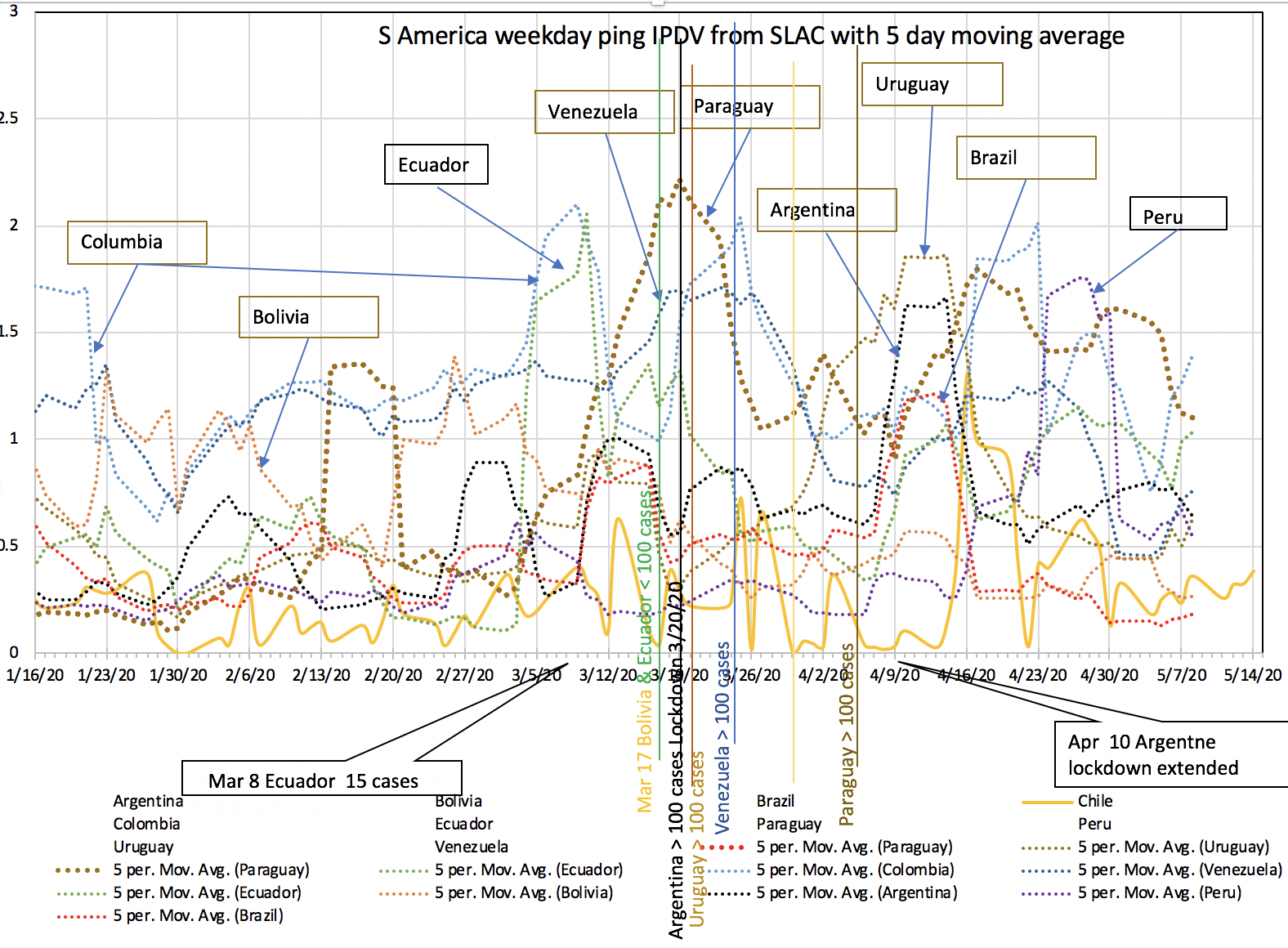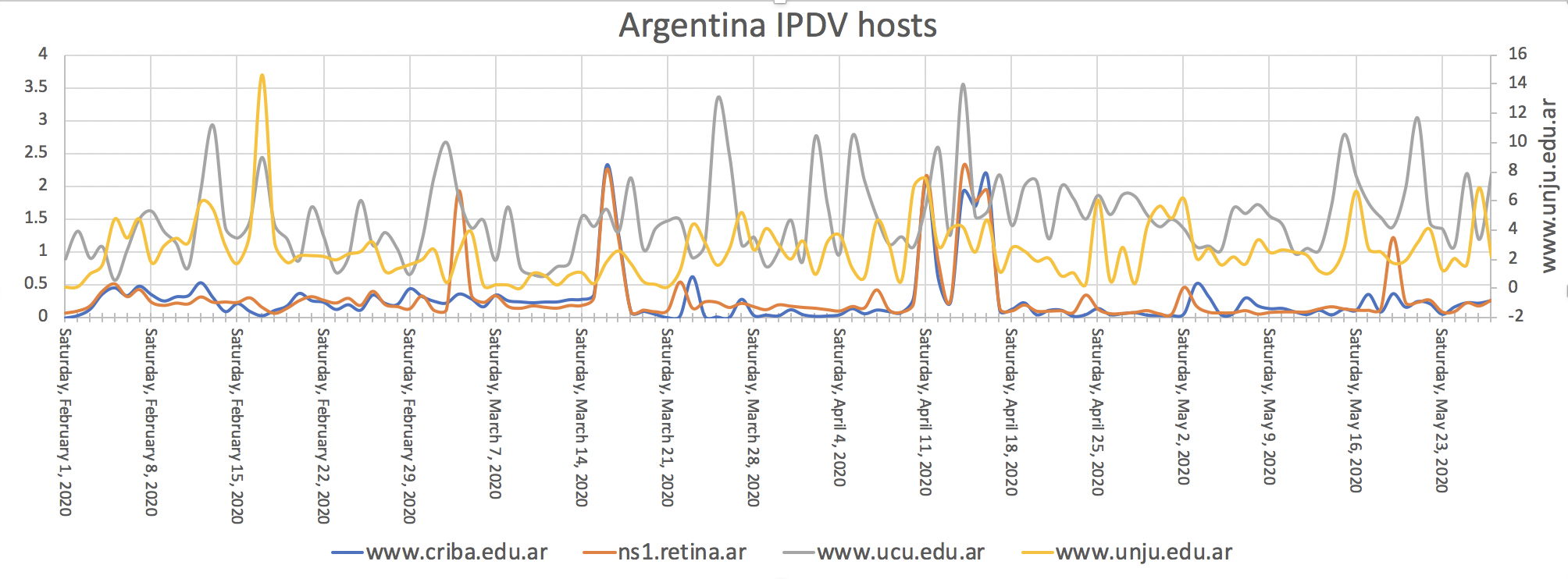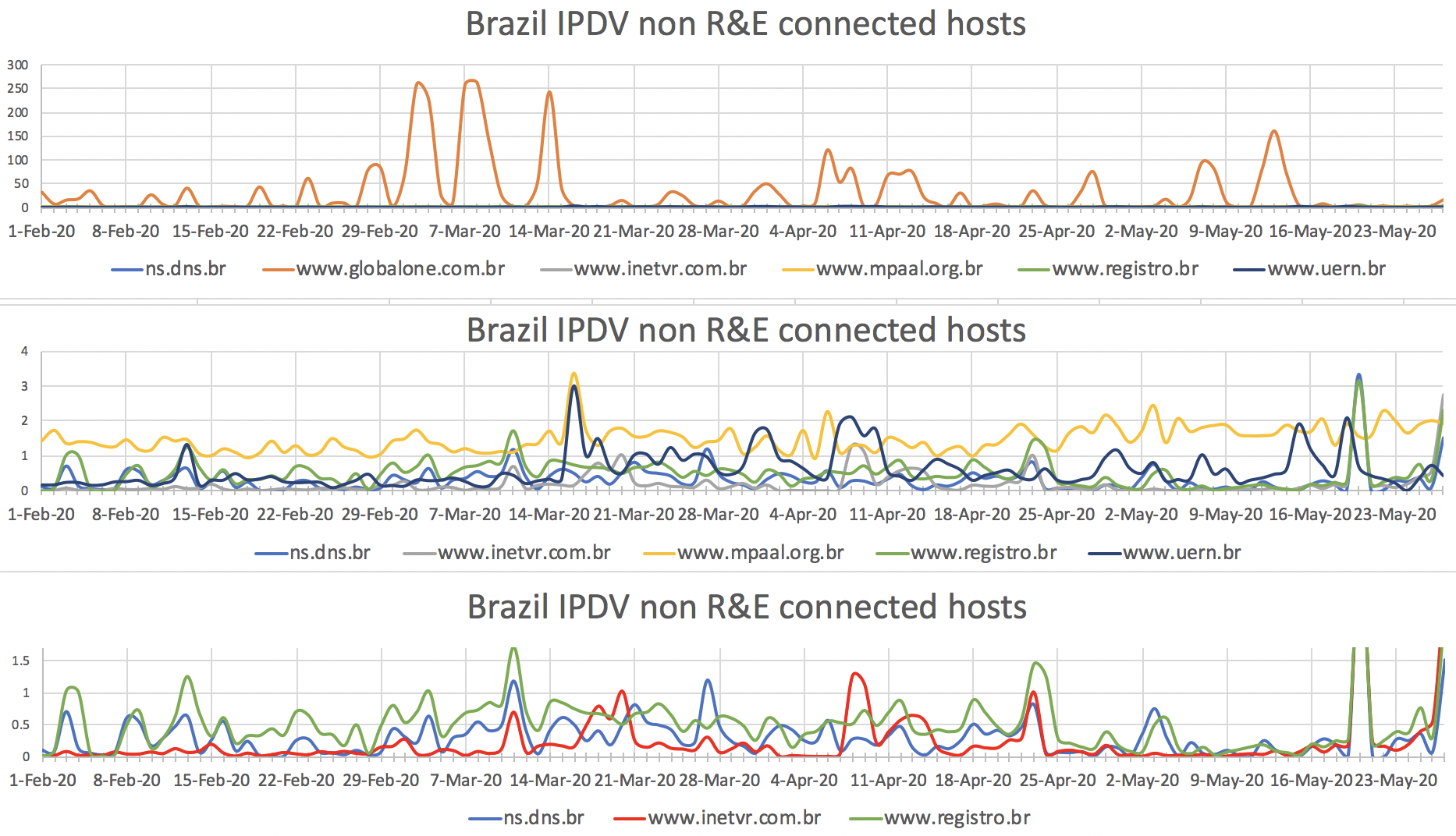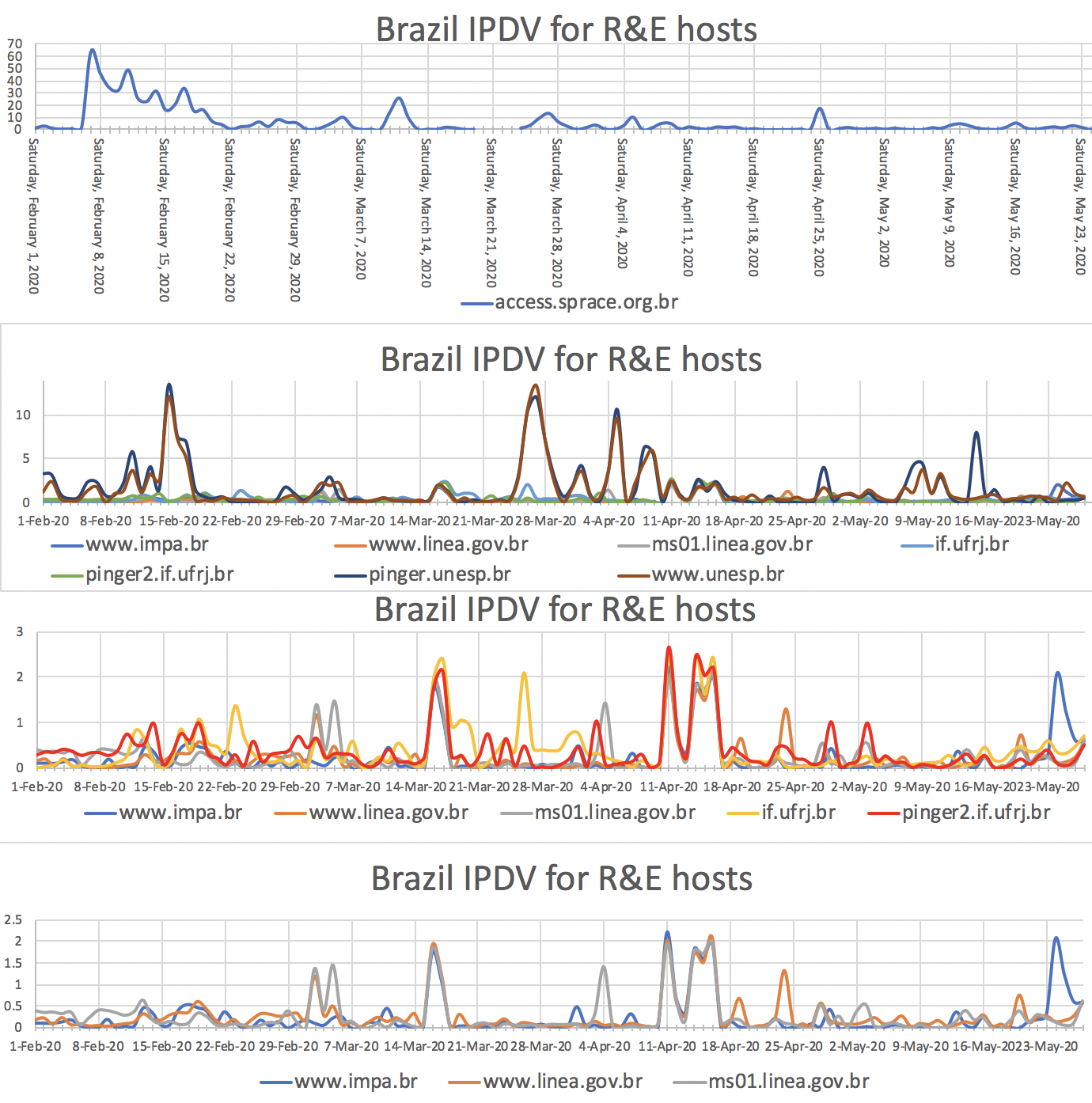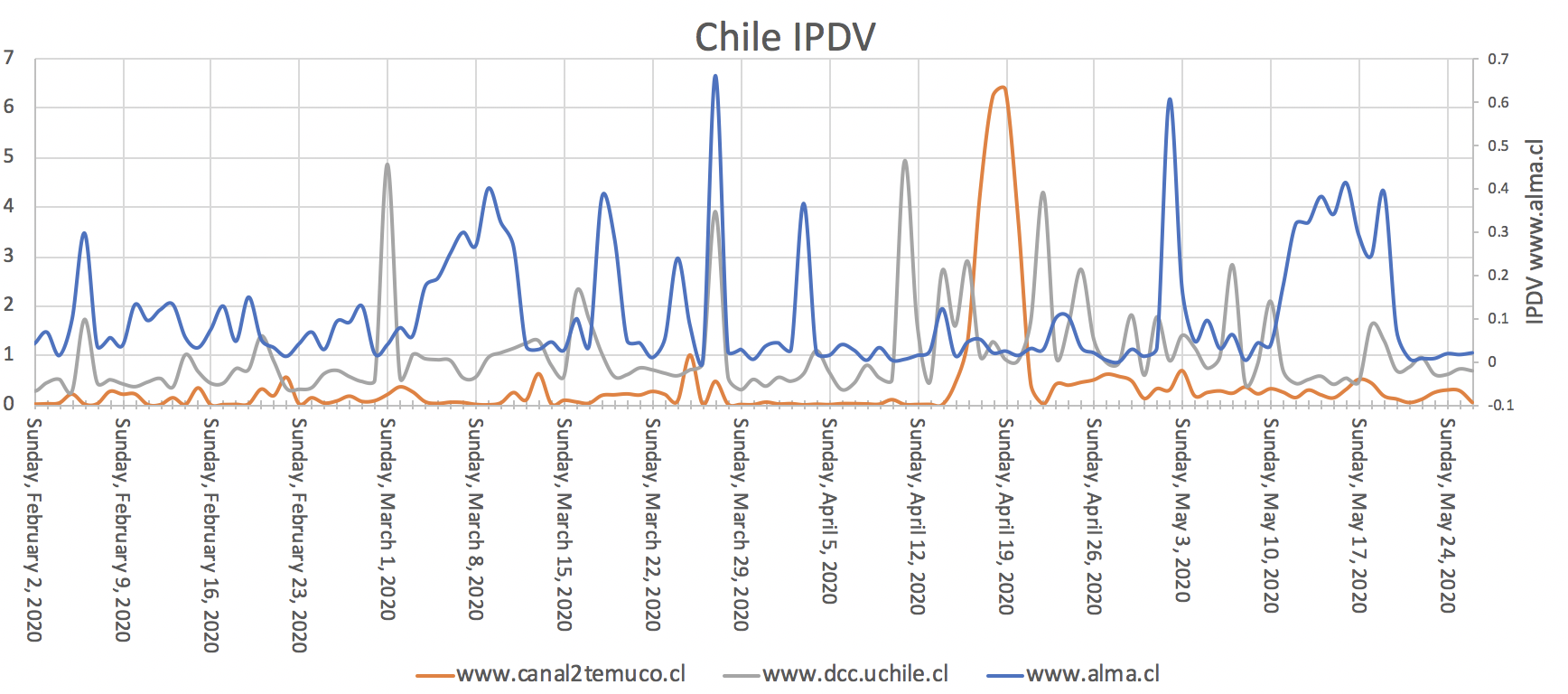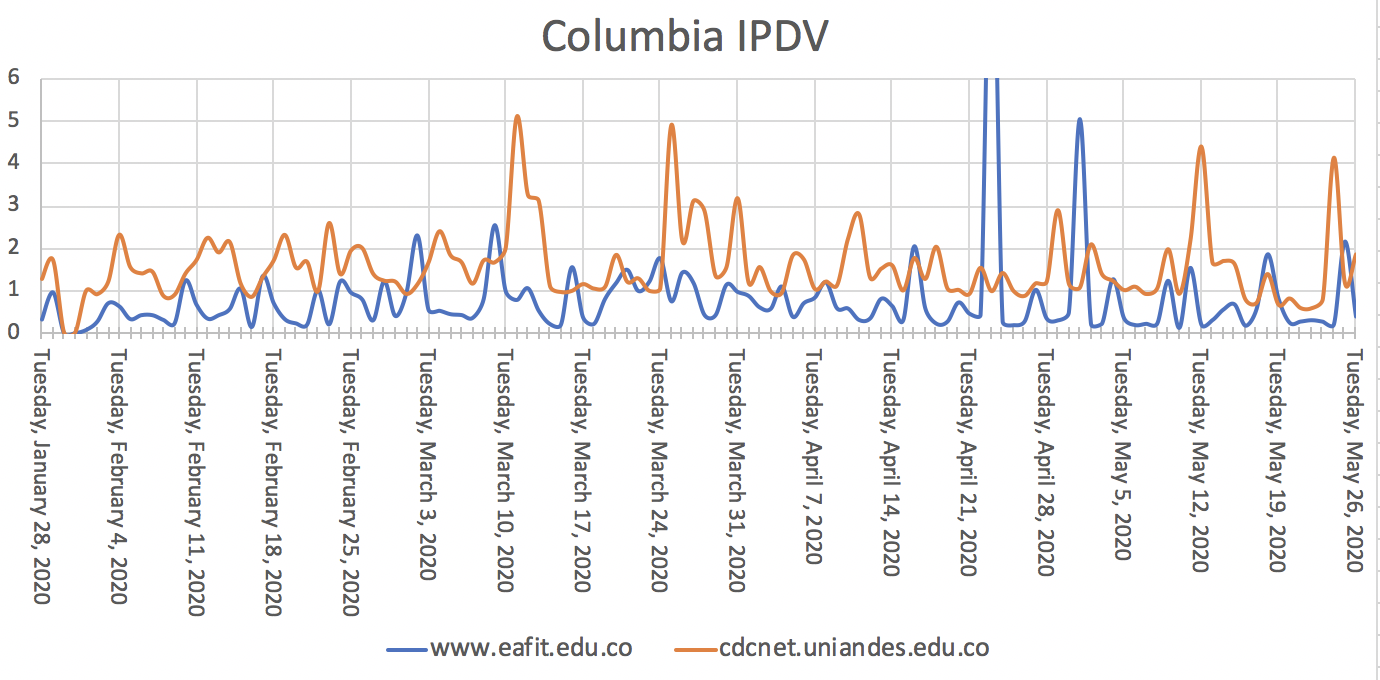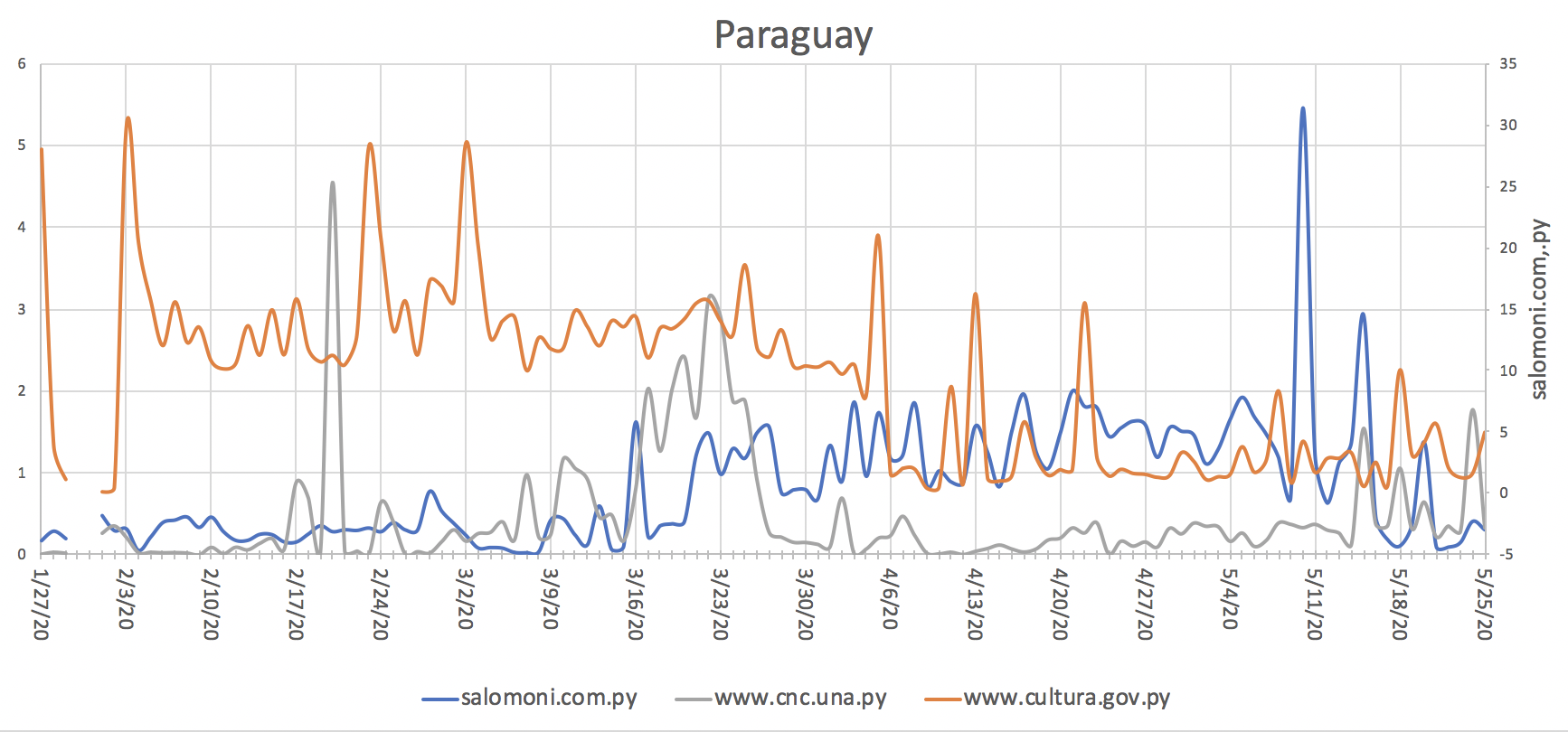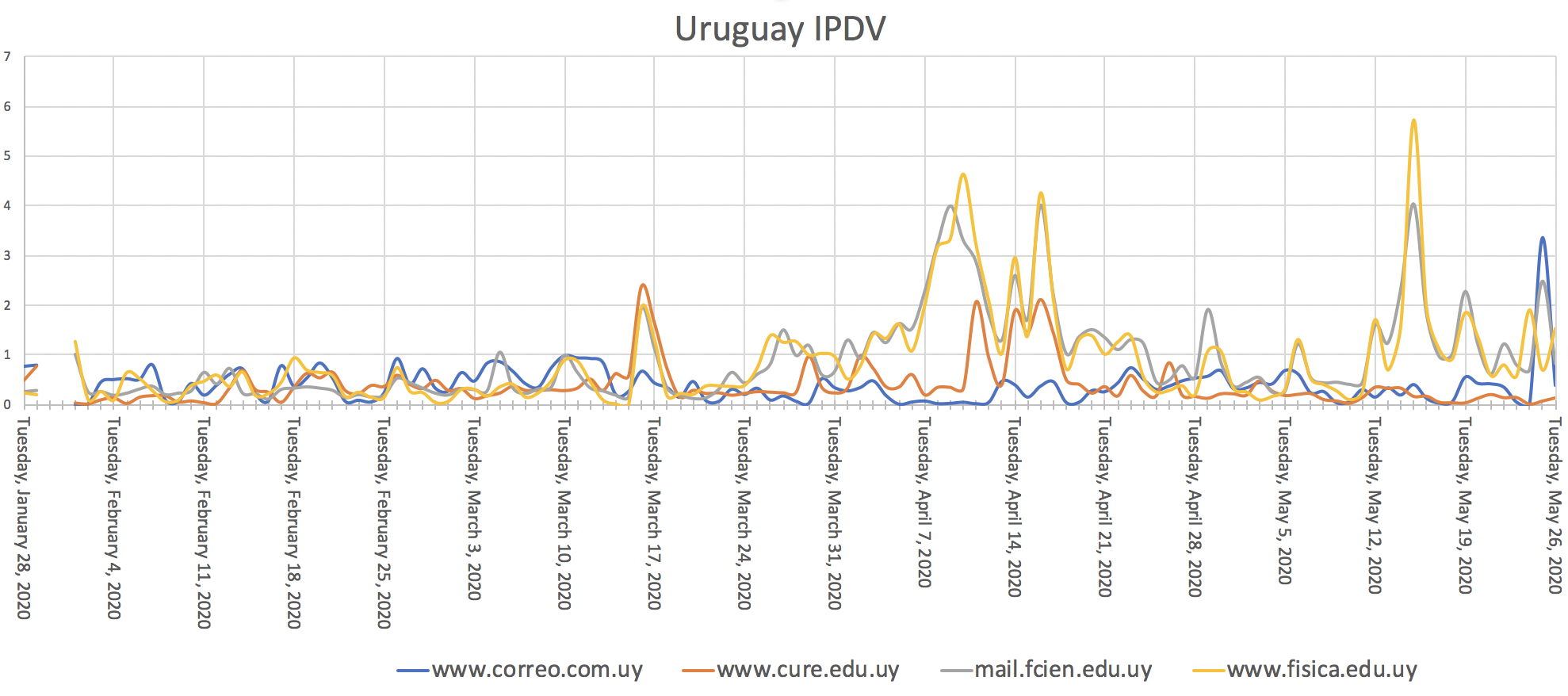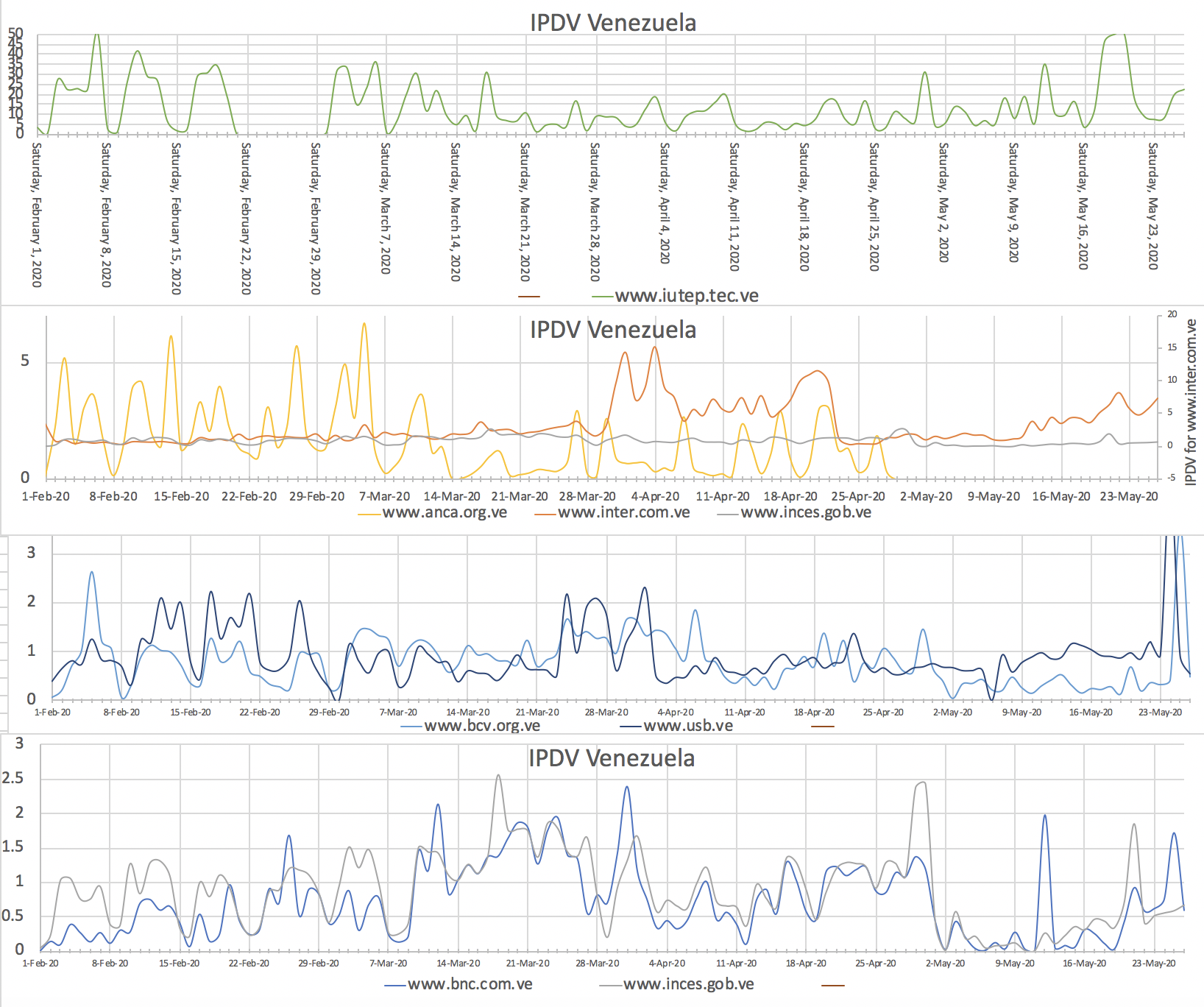All Countries
In this case we tried smoothing the data with a running average over the last week (7 days bearing in mind that since we only recorded weekdays only 5 days were joined in the running average). This also means that the days shown at the bottom are in some sense 7 days ahead of the data. We gave up on this and instead decided to look at all days and the individual countries and their hosts.
Argentina
PimgER monitors 4 hosts in Argentina:
- www.criba.edu.ar the Centro Regional de Investigaciones Basicas y Aplicadas de Bahia Blanca in Buenos Aires. The links are by ESnet and REDCLARA R&E organizations.
- ns1.retina.ar the Red Nacional de Invest ia gacion y Educacion de Argenta in Buenos Aires with links by ESnet, REDCLARA and RETINA R&E organizations.
- www.ucu.edu.ar the Universidad del Concepcion Uruguay about 125 rmiles of Buenos Aires and links via public network links such as Level3.
- www.unju.edu.ar Universidad Nacional de Jujuy in the N E corner of Argentina is about 500 miles NNE of Buenos Aires, and has links via ESnet, REDCLARA then to AS3597 (Foundation InnovaT). I am not sure if it should be classed as an R&E link.
According to https://en.wikipedia.org/wiki/COVID-19_pandemic_in_Argentina the first death was on Mar 7, on Mar 19 a nationwide lockdown was imposed. On Apr 25 the lockdown was reduced for Jujuy.
Looking at the IPDV chart below we see:
- www.criba.edu and ns1.criba.edu.ar the two hosts in Buenos Aires with R&E links track one another fairly closely
- following the Mar 19 lockdown, the following 20 days had a lower IPDV for www.criba.edu and ns1.criba.edu.ar, then for Apr 11-17 there is an increase in IPV followed by another 4 weeks of low IPDV compared to Feb 1- Mar 17.
- The spreadsheet can be found here.
Brazil
PingER monitors 14 hosts in Brazil. Eight are connected to SLAC by high performance Research and Education (R&E) network links traversing ESnet, AMPATH, RNP and FAPERT. The other six are connected by public networks.
- Brazil R&E hosts: www.impa.br in Rio de Janeiro, www.linea.gov.br and ms01.linea.gov.br in Rio de Janeiro, access.sprace.org.br in Sao Paolo, if.ufrj.br and pinger.ifrj.br in Rio de Janeiro, ping.unesp.br and www.unesp.br in Sao Paolo
- Brazil public hosts: ns.dns.br in Brasilia , www.globalone.com.br in Brasilia, www.inetvr.com.br in Salto in the state of Sao Poalo, www.mpaal.org.br in Sao Paolo, www.registro.br in Brasilia, www.uern.br (Universidade do Estado do Rio Grande do Norte )
According to https://en.wikipedia.org/wiki/COVID-19_pandemic_in_Brazil, The first case in Brazil was Feb 25, Mar 17 was the first death. There have been no nationwide closures of schools, just local. On 18 March, Rio de Janeiro and five other municipalities—São Gonçalo, Guapimirim, Niterói, Nova Iguaçu, and Mesquita—in the state of Rio de Janeiro had declared a state of emergency to help contain the coronavirus. Mar 20, the government of Rio Grande do Norte declared a public emergency situation. Mar 21 the State of São Paulo declared a state-wide quarantine. All commerce and non-essential services were to close 24 March.
We divide the PingER data for Brazil into two sets. One for Brazilian R&E hosts and the other for non R&E or public hosts. For several hosts, there is a change in behavior starting around the same time as the interventions mentioned above.
- www.globalone.com.br has a strangely high IPDVs of hundreds of milli seconds. Looking at the hourly ping RTTs we see
- Starting Mar 16 the IPDV to www.uern.br in Rio Grande do Norte increases by over a factor of 2 for over a month
- The hosts ns.dns.br and www.registo in Brasilia track one another both seeing an increase in IPDV starting Mar 12
- The R&E host access.sprace.org.br has a strangely high IPDV
- The two R&E hosts at UNESP in Sao Paolo track one another fairly closely both seeing a spike in IPDV Mar 11 followed by a sustained increase until the end of April
- The two linea.gov.br hosts track one another closely as might be expected. From Feb 1-Mar 17, the average IPDV of the two linea hosts is 0.29+-0.07msec, whereas from Mar 18 thru Apr 1 the average drops to 0.075+- 0.07msec.
Bolivia
PingER monitors 3 Universities in Bolivia.
According to https://en.wikipedia.org/wiki/COVID-19_pandemic_in_Bolivia on March 17, the minister of the presidency, Yerko Núñez, declared a public health emergency and arranged a series of quarantine measures including social sporting, religious, and other activities and gatherings are prohibited. A nationwide quarantine was in effect from 22 March at midnight (00:00). The spreadsheet is here.
Chile
PingER monitors three hosts in Chile: www.canal2temuco.cl is a TV channel located near to La Serena about 300 miles North of the capital Santiago, www.alma.cl is the Atacama Large Millimeter/submillimeter Array (ALMA) headquarters in Santiago, and the University of Chile ( www.dcc.uchile.cl) in Santiago. According to https://en.wikipedia.org/wiki/COVID-19_pandemic_in_Chile on Mar 20 quarantine was imposed on 2 sectors of Santiago, Mar 265 lockdown of greater Santiago, Mar 28 complete lockdown of. Temuco, on 16 May 2020, the whole city of Santiago was put under mandatory quarantine due to an increase of cases.
Colombia
PingER monitors two hosts in Columbia: www.eafit.co in Medellin and cdcnet.uniandes.edu.co in the capital Bogoto. Looking at https://en.wikipedia.org/wiki/COVID-19_pandemic_in_Colombia on 12 March, the government announced seven measures to slow the spread of the disease, including the suspension of educational activities in schools and universities. On March 15th President Iván Duque, along with the Ministries of Health and Education, announced suspension of classes for all public and private schools and universities in the country. Three does not appear to be any correlation with these interventions. The spreadsheet is here.
Ecuador
PingER monitors two hosts in Ecuador. They are both university hosts. The Unidad Educativa Particular La Salle Conocoto (www.lasalleconocoto.edu.ec) is located about 10 miles South of Quito. The other is the Army Polytechnic School (www.espe.edu.ec) also located on the Southern outskirts of Quito.
According to https://en.wikipedia.org/wiki/COVID-19_pandemic_in_Ecuador on Friday March 13th the government suspended class attendance for students at all levels. The following week there is a sustained fairly dramatic rise in the IPDV for www.lasalleconocoto.edu.ec. Also the background IPDV level for www.espe.edu.ec increases by a factor of two to three at the same time. The spreadsheet can be found here.
Paraguay
PingER monitors 3 hosts in Paraguay: a commercial host belonging to Salomoni and Associates Attorneys and Counselors salomoni.com.py, the National Secretary of Culture www.cultura.gov.py and the Universidad Nacional de Asuncion. All are in the capital Asuncion. According to https://en.wikipedia.org/wiki/COVID-19_pandemic_in_Paraguay, on 10 March 2020, the Paraguayan government suspended classes and all activities that involve groups of people, as well as public and private events. On Mar 15 the government announced a nighttime curfew was announced. On Mar 20 the first death and the first case of community transmission were confirmed and the government declared a total quarantine and public movement is restricted to buying food, medicine and other essential items. In the IPDV chart below there are increases in the daily IPDV for both salomoni.co.py and www.cnc.una.py around 3/16/2020. Again around Mar 20 salomoni.com.py increases and this time persists through the following month. The drop in IPDV for www.cultura.gov.py does not appear to be related to the above interventions. The spreadsheet is here.
Peru
During this period PingER monitored 4 hosts in Peru. Three are universities: the Universidad Nacional de San Antonio Abad del Cusco (www.unsaac.edu.pe), the Universidad del Pacifico (www.up.edu.pe) in Lima, the Graduate School of the Universidad del Pacifico (espg.up.edu.pe) in Arequipa, and the Army Information Portal (www.ejercito.mil.pe) in Lima. The Universidad del Pacifico stopped responding Feb 20 and the Universidad Nacional de San Antonio Abad del Cusco stopped responding Mar 23. Apart from two large spikes www.unsaac.edu.pe is almost flat.
Looking at https://en.wikipedia.org/wiki/COVID-19_pandemic_in_Peru we see: on 15 March, President Martín Vizcarra made a national announcement, declaring a 15-day quarantine effective from 16 March. On 17 March, the second full day of quarantine, citizens were required to fill out an online form in order to obtain permission to leave home. On 18 March, the government tightened the measures of quarantine, implementing a curfew from 8 PM-5 AM where citizens are not allowed to leave their homes. On 2 April, the President made a live announcement to the country that for the remaining 10 days of quarantine, they would add one more restriction in order to flatten the curve. Mobilization outside of the house will be limited by days. Only men will be able to leave the house to buy groceries, medicines, or go to the bank on Monday, Wednesday, and Friday.[27] Only women are allowed outside on Tuesday, Thursday, and Saturday. No one is allowed on Sunday. These restrictions are to allow easy identification by police and military (rather than others that require more precise identification, such as even and odd numbers of each person's DNI number), and to reduce circulation by 50%.[28] Wearing of masks in public was officially declared compulsory, although it was a rule enforced by police and military for a few weeks up to this announcement
Looking at the chart below we see that following the quarantine effective 16 Mar the IPDV for www.ejercito.mil.pe is reduced by over a factor of 2 and stays that way until at least the middle of April.
Uruguay
PingER monitors 4 hosts in Uruguay. Three are universities, two located in Montevideo (www.fisica.edu.uy and mail.fcien.edu.uy from campuses of the Univesity of the Republic) home to about 1/3 of the country's population, one (www.cure.edu.uy) is located in Villa Sara North Eastern Uruguay, and one is a commercial site located in Loscano in Eastern Uruguay. As expected the tow host at the University of the Republic track on. another fairly closely.
The University of the Republic cancelled classes on Friday Mar 13. The government announced suspending classes at private and public schools on Friday Mar 14. The following Monday & Tuesday there is a sharp rise in the IPDV the three universities.
The spreadsheet of the PingER data is here.
Venezuela
PingER monitors 7 hosts in Venezuela. These are: the Banco National Credito (www.bnc.com.ve) in Caracas; www.inter.com.ve a commercial site in Maracan; www.inces.gob.ve a government site in Tucupita; the Banco Central de Venezuela (www.bcv.org.ve) in Caracas; the Asociacion Nacional de Cultivadores Agricolas (www.anca.org.ve) in Araure, the Ministerio del poder popular para Educacion universiteria ciencia i tecnologia in Acarigua (www.iutep.tec.ve); and the Simon Bolivar University in Caracas (www.usb.ve) in Caracas.
According to https://en.wikipedia.org/wiki/COVID-19_pandemic_in_Venezuela stay at home orders were announced on 15 March and introduced the next day across six states and the Caracas area. All classes would be suspended at public and private schools from Monday 16 March. March 16 Madiro extended the quarantine to the entire country and went into lockdown on 17 March. The first confirmed death from the disease was announced on 26 March.
Comparing the interventions with the PingER IPDV measurements below we see:
- starting Mar 18 a decrease in the midweek IPDV of a factor of 2-3 for www.iutep.tec.ve following the Mar 140-15 interventions
- no impact on the government host www.inces.gob.ve
- a big decrease in the IPDV for www.anca.org.ve in the 2 weeks following the Mar 14-15 interventions
- there is a big increase in the IPDV for www.anca.org.ve starting Mar 30 and lasting until Apr 22, that is NOT correlated with the interventions above.
- www.bnc.com.ve and www.inces.gob.ve track one another fairly closely. Starting Mar 14 the differences in the Monday-Friday IPDVs compared to the weekend IPDVs are much reduced, possibly due to interventions making the behaviors more uniform.
